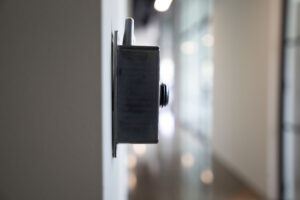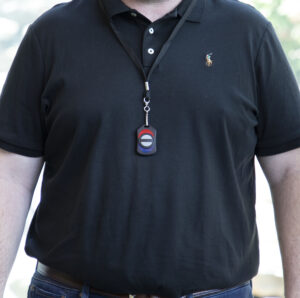
Lone Worker Devices: Complete Buyer’s Guide for Hotels, Retail, and Healthcare
Choosing the right lone worker device for your business is crucial for both lone worker safety and regulatory compliance.
With new workplace violence prevention rules requiring businesses to provide panic buttons and safety devices to employees, finding the right technology is key to protecting your workforce and avoiding costly violations.
If you’re a hotel safety manager researching panic buttons, an HR director evaluating GPS safety trackers, or a business owner trying to figure out what lone worker devices your team actually needs, this guide will help you cut through the confusion.
Let’s explore what works, what doesn’t, and how to choose lone worker devices that your team will actually use when they need help.
What Is a Lone Worker Device? Let’s Break Down Your Options
A lone worker device is any technology that gives isolated employees a way to summon for help quickly.
The recent surge in workplace violence prevention regulations has created specific requirements for these devices, especially in hospitality, retail, and healthcare. Understanding these requirements upfront will save you headaches later.
Key Requirements for Compliance
Most state laws and industry standards require lone worker devices to include:
GPS Tracking Capabilities: Devices need to tell responders where your employee is located. Check your state’s specific accuracy requirements as they vary by jurisdiction.
Silent Alert Options: Sometimes you need help without making a scene. This is especially important for hotel panic buttons and retail environments where you don’t want to escalate a situation.
911 Integration: While some laws require internal alerts first, your devices should ultimately connect to emergency services when necessary.
Reliable Connectivity: Your devices have to work everywhere your employees do—including basements, stairwells, and remote areas where cell coverage might be spotty.
Simple Activation: When someone’s in trouble, they need one-button help. Complex procedures fail when tensions are high.
Learn more about state-specific Workplace Violence Prevention Regulations
Types of Lone Worker Safety Devices: Which One Fits Your Needs?
There are three main types of lone worker devices, and each has its place depending on your industry and how your employees work.
Wearable Lone Worker Devices
What They Are: Physical devices that employees wear or carry, like wearable panic buttons that fit on lanyards or in a pocket.
Best For: Places where smartphones aren’t practical or allowed, like certain healthcare settings, industrial facilities, or in public retail spaces.
Pros:
- Built for emergencies
- Portable and wireless
- Good battery life
- Doesn’t depend on personal phones
Considerations:
- More hardware to buy and maintain
- Easier to forget, lose, or break
Mobile App-Based Alert Systems
What They Are: Apps that turn your employees’ smartphones, desktops, or tablets into alert systems.
Best For: Most hospitality, retail, and office environments where people already use or carry mobile devices.
Pros:
- Uses devices people already have
- Easy to install and update
- Works with GPS, camera, and other features
- Everyone knows how to use a phone
- Two-way communication with responders
- Ability to send alerts to multiple colleagues and responders simultaneously
- Completely customizable alerts
Considerations:
- Dependent on employee remembering to carry device
Industry Applications: Hotels, retail stores, office buildings, healthcare administration.
Fixed Panic Buttons
What They Are: Panic buttons installed in specific spots like reception desks, patient rooms, or behind retail counters.
Best For: Places where employees work in the same spot most of the time.
Pros:
- Always in the same place
- Easy USB installation
- Can work with your existing infrastructure and security setup
- Very reliable when you need them
Considerations:
- Only work in specific locations
- No help for employees who move around
Industry Applications: Hotel front desks, healthcare nurse stations, retail checkout areas.
Hotel Panic Buttons: What You Need to Know
Hotels have some unique challenges when it comes to lone worker devices, especially for housekeeping staff working alone in guest rooms.
What Hotels Need to Comply With
Several states and cities now require hotels to provide panic buttons for employees working alone:
- New Jersey: Hotels with 100+ rooms need panic devices
- New York: Broad workplace violence prevention requirements
- Washington State: All hotels need panic buttons for lone workers
- Major Cities: Seattle, Chicago, Los Angeles, and others have their own hotel requirements
What Makes Hotel Panic Buttons Different
- Discrete Operation: Your devices need to work silently without alarming guests or making dangerous situations worse.
- Quick Response: Hotel panic buttons should alert your security or management team within seconds, not just emergency services.
- Location Accuracy: Your response team needs to know which area needs help.
- Integration: The system should work with your existing hotel security and communication setup.
The Real-World Challenges
- Guest Areas: Devices have to work reliably in guest rooms, hallways, and service areas without affecting the guest experience.
- Staff Turnover: High hospitality turnover means you need simple training and device procedures.
- 24/7 Operations: Hotels need around-the-clock response capabilities.
Common Implementation Problems (and How to Solve Them)
Even great lone worker devices can fail if you don’t implement them properly. Here are the problems we see most often and how to avoid them.
Installation Complexity: Wireless vs. Hardwired
- The Problem: Many traditional panic button systems require extensive hardwiring, electrical work, and professional installation that can take weeks and cost thousands.
- The Solution: Modern wireless solutions eliminate installation complexity. TeamAlert’s system requires no hardwiring. Our solutions connect via Bluetooth and existing Wi-Fi or cellular networks. Setup takes hours, not weeks, and doesn’t require electricians or facility modifications.
- Why This Matters: Quick deployment means faster compliance and immediate employee protection.
Cost Scaling Issues
- The Problem: Traditional pricing models become cost-prohibitive as businesses grow.
- The Solution: Look for solutions offering affordable tiered pricing and unlimited alerts. TeamAlert offers competitive pricing that doesn’t penalize growth. You can add employees without adding exponential costs.
- Why This Matters: Sustainable pricing allows you to protect your entire workforce, not just a subset based on budget constraints.
Staff Turnover Complications
- The Problem: High turnover industries like hospitality and retail struggle with device assignment, training, and equipment management when employees come and go frequently.
- The Solution: Choose solutions with device-independent operation. TeamAlert’s Bluetooth devices aren’t assigned to specific individuals. Any employee can download the app and use any Bluetooth device, eliminating complex assignment and reassignment procedures.
- Why This Matters: Simplified device management reduces administrative burden and ensures continuous coverage regardless of staffing changes.
Coverage and Connectivity Issues
- The Problem: Many devices fail in areas with poor cell coverage, thick walls, or interference from other electronics.
- The Solution: Multi-network solutions that use Wi-Fi, cellular, and Bluetooth connectivity provide redundant communication paths. TeamAlert automatically switches between available networks to ensure consistent connectivity.
- Why This Matters: Reliable connectivity is non-negotiable for emergency devices. If it doesn’t work when needed, it’s useless.
Staff Adoption Strategies: Getting Your Team to Actually Use Safety Technology
The best lone worker devices are worthless if employees don’t use them consistently.
Here’s how to ensure high adoption rates and proper usage.
Simple Onboarding Process
- Start Fast: Employees should be able to use devices within minutes of receiving them. TeamAlert provides same-day deployment. Download the app, show employees the user-friendly interface, and they’re ready.
- Minimize Technical Complexity: Avoid solutions requiring extensive setup, password management, or technical troubleshooting. The emergency button should be obvious and accessible.
- Integrate with Existing Workflows: Don’t force employees to completely change their routines. The best solutions work with existing processes.
Comprehensive Training Programs
- Basic Operation: Every employee needs to know how to activate an alert, what happens when they do, de-activate an accidental alert, and how to respond properly. Every new TeamAlert user goes through quick, but comprehensive online onboarding.
- Scenario-Based Training: Practice different emergency types—medical emergencies, workplace violence, and equipment accidents each require different alerts and responses.
- Regular Refresher Sessions: Monthly practice ensures employees remember procedures and stay comfortable with the technology. TeamAlert offers customers as-needed refresher training with a designated TeamAlert Success Guide.
Employee Onboarding Integration
- Make It Standard: Include lone worker device training in your standard employee onboarding process, not as an afterthought.
- Management Buy-In: Supervisors and managers must understand and support the system for employees to take it seriously.
- Clear Expectations: Employees need to understand when to use devices, when not to, and what constitutes appropriate usage.
Building Confidence Through Practice
- Monthly Drills: Regular practice builds muscle memory and confidence. We recommend monthly testing to ensure employees can activate alerts quickly under stress.
- Positive Reinforcement: Recognize employees who follow safety protocols and use devices appropriately.
- Open Communication: Create channels for employees to report issues, suggest improvements, or ask questions about the system.
Maintenance and Monitoring: Keeping Your System Reliable
Lone worker devices require ongoing maintenance and monitoring to remain effective. Here’s what to look for in support and administration.
Simple Administration
- User-Friendly Dashboard: Administrators need clear visibility into device status, user access, reports, and system updates without technical expertise.
- Automated Reporting: Compliance requires documentation—choose systems that automatically generate reports after each alert.
- Easy User Management: Adding, removing, or modifying employee access should be straightforward, especially for businesses with high turnover.
Automatic Updates and Maintenance
- Software Updates: Devices should receive automatic updates without requiring manual intervention or system downtime.
- Battery Monitoring: Systems should alert administrators when device batteries are low, ideally before they affect functionality.
- Connectivity Testing: Automatic system testing ensures devices work when needed without requiring manual checks.
Quality Support and Partnership
- Real Human Support: When emergencies happen, you need human expertise, not chatbots or offshore call centers. TeamAlert provides real human support from our team based in Alabama—an American company whose mission is making teams safer.
- Local Emergency Coordination: Support teams should understand local emergency services and be able to coordinate responses effectively.
- Proactive Monitoring: The best providers offer system monitoring and continually work to update their systems to improve employee safety.
- Training and Implementation Support: Look for providers who offer comprehensive training, implementation guidance, and ongoing support rather than just selling devices.
Making the Right Choice: Key Questions to Ask
Before making a final decision, ask potential providers these critical questions:
Technical Requirements
- Does the system work reliably in all areas of our facility?
- What happens if Wi-Fi or cellular service is interrupted?
- How quickly are alerts received and processed?
- Can the system integrate with our existing security and communication systems?
Compliance and Legal
- Does this solution meet our state’s specific requirements?
- What documentation and reporting does the system provide?
- How does the system handle privacy and data security requirements?
Implementation and Support
- How long does implementation take, and what’s required from our team?
- What training and ongoing support is provided?
- How are system updates and maintenance handled?
- What are the true total costs, including hidden fees and ongoing expenses?
Scalability and Growth
- Can we easily add or remove users as our business changes?
- How does pricing scale with our growth?
- Can the system adapt to new locations or operational changes?
Why TeamAlert Is the Right Choice for Your Business
TeamAlert addresses major challenges businesses face when implementing lone worker devices:
- No Installation Hassle: Our wireless solution requires no hardwiring, electrical work, or facility modifications. Deploy in hours, not weeks.
- Predictable Costs: Affordable, competitive pricing that doesn’t penalize growth. Protect your entire team – big or small – without budget anxiety.
- Simple Operations: Bluetooth devices work with any employee. No complex assignment or management procedures.
- Reliable Connectivity: Multi-network connectivity ensures your devices work everywhere your employees do.
- Same-Day Deployment: Download the app, show employees the emergency button, and you’re good to go.
- Real Human Support: American-based team focused exclusively on making workplaces safer.
- Automatic Maintenance: Updates push automatically and system health is continuously checked.
Ready to Protect Your Team?
Your employees’ safety can’t wait for the perfect solution—but you also can’t afford to choose the wrong one. TeamAlert provides the reliability, simplicity, and support you need to protect your lone workers.
Try TeamAlert free for 2 weeks and see how easy it is to implement effective lone worker protection. No contracts, no risk—just the peace of mind that comes from knowing your team can get help when they need it most.
Questions about specific requirements for your industry or location? Contact our team for a personalized consultation and compliance review. Schedule a call with a TeamAlert team member today.

